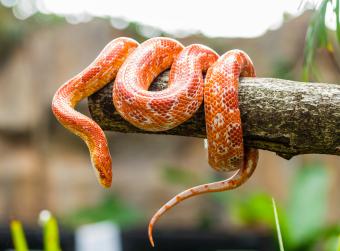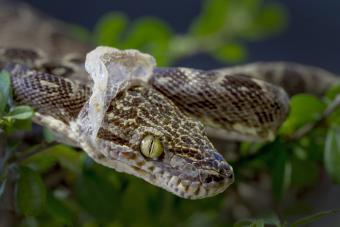
Green tree pythons have become increasingly popular among reptile enthusiasts due to their stunning appearance and unique behavior. However, they are not the easiest snake species to care for and do best wwith an experienced reptile keeper. They aren't for beginners, but do make interesting pets for the right home.
Background
Green tree pythons are native to the tropical rainforests of New Guinea, Indonesia, and the Cape York Peninsula of Australia. They thrive in warm, humid environments with dense foliage. In their natural environment, their vibrant green coloration allows them to blend in seamlessly with their surroundings.
Appearance and Size
Green tree pythons are vibrant green in color, hence their name. You may also notice yellow, green, or blue spots and yellow or white vertebral stripes along the snake's body. Baby green tree pythons don't possess the same vibrant color. Instead, they are born bright yellow, red, or a red-brown. They don't change to the green coloration until they're 6 to 12 months old.
The babies are a different color to aid in their survival. Yellow blends into the rainforest, whereas red aids in blending with the forest floor and branches. Green adults live in the leaves of tall trees. The adults can reach lengths of 5 feet.
Temperament
Green tree pythons are primarily nocturnal and arboreal, spending most of their time coiled on branches, waiting for prey. Due to their natural ambush hunting strategy, they can be more defensive and prone to striking when they feel threatened or stressed.
Although they may tolerate spending time with you if the are socialized from a young age, they will never have the same temperament as more docile pet snakes like the corn snake. Most of the time, it's better not to pick these snakes up too much.
Handling Your Green Tree Python
Babies should never be handled, as they are fragile and can become stressed very easily. However, once your snake gets out of the baby stage, some handling will be necessary. For example, when you move your snake from one enclosure to another, or if they need to visit the veterinarian.
Aside from these instances, this is not a snake species to be held. They do not enjoy handling and can become aggressive if they feel like they're being handled too much. They are a snake to adore from afar, not a snake to hang out with you.
Care Requirements

Unlike the ball python, this snake is a more advanced species. They're not too difficult to keep, but they aren't the easiest snakes to maintain, either. This snake's care requirements are more extensive relative to other species. Prior to purchasing this snake, ensure the enclosure and all components are set up and ready to go.
Enclosure Setup
A glass aquarium is not recommended for pythons, especially not this species. They can become easily stressed when they're approached from above, which is why you see many habitats for snakes with side doors. Since this is such a large snake, they will require a large enclosure.
The habitat should be longer than the length of the snake, so they're able to fully stretch out. They can reach 5 feet in length, so keep this in mind if you're purchasing a baby. If you are purchasing a baby, you can purchase a smaller enclosure to begin with while you're searching for the right adult enclosure. The baby snake will likely feel more secure this way to begin with anyway, as they will feel less exposed to the outside environment.
This snake's enclosure must also be taller than it is wide to allow for climbing. Large perches, like tree limbs, should be placed in this snake's enclosure, regardless of age. The enclosure must also have appropriate ventilation. Generally, this involves drilled holes in the sides or the top, while some people prefer to have a screened top.
All openings to the enclosure must be locked to prevent the snake from escaping.
Temperature and Lighting
The temperature in this python's enclosure should remain between 86 to 88 degrees Fahrenheit in the warmest area. However, it's important to ensure there are a range of temperatures for them to get to. The cooler side of the tank should remain around 78 to 80 degrees and night-time temperatures can drop to about 75 degrees Fahrenheit. You should never allow the temperature to drop below 70 degrees, as this could be detrimental to your pet snake.
Green tree pythons don't require special lighting. However, if you do want to show off their vibrant color when you're able to see them in the enclosure, you can grab some full-spectrum lighting.
Humidity

Maintaining the appropriate humidity levels can prove difficult in a large enclosure like these snakes enjoy. However, to ensure good health, this snake requires a certain range of temperature and humidity levels. The enclosure should be humid, but not wet.
In order to get the appropriate balance, you will want to purchase an over-the-cage heating lamp, a radiant heat panel, or a ceramic heat emitter. Both a thermometer and hydrometer are necessary to ensure the temperature and humidity combined are appropriate. Humidity levels can range between 40 to 70%.
Maintaining this range is important. Humidity should increase at night to the high end of the range, near 70 percent. During the day, you should let humidity levels drop toward 40 percent.
To keep humidity up, you can mist your snake's enclosure around twice a day. It's easier to use an automatic misting system for your snake's setup, however, so if you don't mind spending a little extra, use one of these to keep humidity in the proper range.
Substrate
Paper-based bedding is recommended for this species because it won't harm them if ingested. Pine and cedar chips should be avoided; they can easily irritate your snake's skin and cause respiratory problems. It should be deep enough for the snake to hide in. Or, if you choose to use reptile carpet, find a hide box large enough for your individual snake.
Diet
The green tree python is carnivorous, feeding on mice and rats in captivity. Although they do well with hunting, if your snake is willing to consume dead prey, their risk of injury will be lower. Feed juveniles every 5 to 7 days and adults every 10 to 14 days. Use feeding tongs to present the prey item, minimizing the risk of accidental bites.
In their natural habitat, or an appropriate enclosure, this snake will dangle their tails for their live prey and capture them when they get close enough to strike.
Water
Place a shallow water bowl at the bottom of the enclosure. It must be large enough not only for the snake to drink out of, but also to lie in during shedding periods. If you notice the water is dirty and your snake isn't in it, replace it as-needed.
Lifespan
Green tree pythons can live 12 to 20 years depending on their health and how well their enclosure replicates their natural habitat. As long as you meet their basic needs, your green tree python should do well. However, it helps if you take your snake to your local exotic pet veterinarian for regular checkups.
Health Concerns
Although this species is generally healthy, they are prone to developing the following issues:
- Ticks and mites
- Stomatitis
- Dermatitis
- Respiratory tract disease
If you notice any abnormalities in your snake's health, contact your veterinarian to make an appointment as soon as possible.
Green tree pythons are considered to be more fragile than other common pet snake species. They're not delicate, but they do best with gentle handling and a high quality of care.
Shedding
Green tree pythons typically start shedding at the head, working their way down the body until the old skin is entirely removed. Ideally, the shed skin will come off in one complete piece, indicating a healthy and successful shed.
Keep an eye on your snake during the shedding process to ensure everything is progressing smoothly. If you notice any issues, such as a stuck shed or difficulty shedding, consult a reptile veterinarian or experienced snake keeper for advice.
Do They Make Good Pets?

Green tree pythons make good pets for a more experienced snake keeper who is looking for a snake to admire throughout the day. They are not good snakes for beginner snake lovers or children. They do not appreciate being held and prefer not to interact with humans.
If you are bitten by this snake, their teeth can inflict serious damage.
Finding Green Tree Pythons
You can find green tree pythons and many specialized reptile stores. Breeders and reptile expos are also good places to find this snake. Special morphs are also out there, but they cost more than standard colors.
Cost
You should expect to pay between $300 to $600 for this pet snake. Some snakes can be higher priced depending on their age and color variation. Some snake enthusiasts have bred these snakes to display certain characteristics, like a more blue color or certain markings.
Best for More Experienced Keepers
Green tree pythons are truly fascinating creatures with their striking appearance, incredible camouflage abilities, and captivating behavior. While they may not be the most beginner-friendly pet snake, with the proper care and dedication, they can make a rewarding and visually stunning addition to any reptile collection. That being said, prior to purchasing one, make sure you have the experience necessary to handle this type of snake.







